December 11, 2004
To the Hills.
Albur is just along the highway, 11.9 kilometers from Tagbilaran. However, there's a huge road expansion project underway, so the ride takes an hour. I've mentioned similar ironies before: it is strange that everybody is already used to all the smoke-belching vehicles on the road, but when it comes to a little dust, everyone holds a handkerchief to his or her face.
I read somewhere that whenever there are road expansion projects, people figure the traffic will lighten up, so a lot more cars (or SUVs) end up on the road. Traffic doesn't decongest. More land becomes a giant parking lot, and pollution worsens. The book or article or whatever I was reading was essentially arguing for improvements in public transit as opposed to road expansion. Maybe it will be different here because there really wasnít a traffic problem before, and most people still donít have the money to buy a motorcycle, but I wouldn't underestimate the dream of freedom of mobility.
So I met the Municipal Planning and Development Coordinator, who immediately told me to call her by her nickname, and we got in a jeep to head up the hill. She was escorting BLDF to visit livelihoods. The first lady we met was tearing raffia fibers into thin strips, to be made into hula skirts. She told us she buys her raffia from a guy who comes around selling it, and then sells her finished skirts to a guy who comes around to take the skirts to town.
A few things had apparently never occurred to her. Raffia is being consumed faster than it is being replenished. She told us she doesn't think whoever is selling her the raffia is bothering to replant for future harvests. So someday, her source of livelihood will vanish, and her skill might be rendered useless.
She probably hasn't ever thought to take the hula skirts to town, in order to eliminate the middle-man and earn more for her hard work. I can't really blame her since itís a pain in the neck to get to town, and she probably sees going into down as taking away time she could spend making hula skirts.
During a brief downpour, we sought shelter in her hut, and had dancing around in hula gear.
From there, we went to another home, further up to the bumpy hill, where more hula business was underway. We observed there were a lot of scraps left over after the useful part of the raffia had been stripped away. We asked what they do with the scraps, and they said they burn them. I wondered why they didn't just heap it into a pile somewhere and let it rot (there's plenty of empty land where they live.) They said snakes would hide there. If there's one thing about Filipinos, they have an answer for everything!
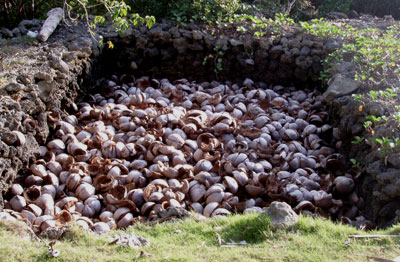
And back down the hill, and to the seaside, where we were looking for a guy who made salt. But all we found were large stone pits filled with coconut husks. I think everyone was utterly confused. This is how you make salt? Finally, some chipper old dude showed up, and began explaining his process to us. (Unfortunately, many old people here have really thick accents, and I find it hard to understand barely anything they say.)
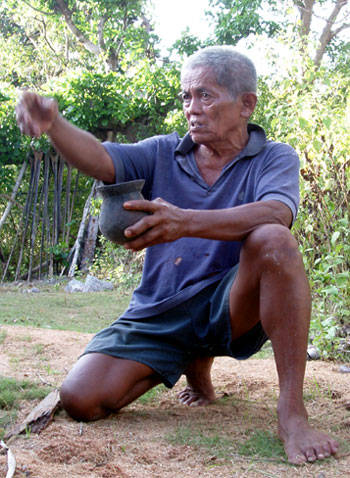
I think Mr. Salt Man waits for high tide to soak his coconut husks, waits again for them to dry, boils the husks, and from the steam extracts salt. But I'm probably completely wrong. I took out my camera and asked if I could take a picture of him. He said sure, as long as I wasn't one of those people who was gonna make him pay for a copy of the picture. He told us he's 70, that he learned his technique from his father, who learned it from his father. He said it used to be a livelihood, but nobody needs his salt anymore, so he just barters for rice. He hadnít bothered to teach his sons how to make salt, and neither had the other three salt makers on Bohol taught their sons. (All four saltiers are cousins, incidentally.) Then his wife called for him from afar, and he scurried away.
We went back to the MPDCís house for snacks, and she invited me to come back to Albur in two days, when theyíd be having a purok (kind of like an American block) education session about waste management.
The next day, I visited a Material Recovery Facility established with the help of a former volunteer. This is a consolidation area where people can bring their recyclables. A junk buyer comes by every so often to pick up the stuff and pay for it. They also have a few people fashioning purses and bags out of Fun Chum juice packs (think Capri-Sun.) However, they are having a hard time keeping the thing going because of competition. The way I see it, if less trash is coming their way, the better. So I was thoroughly confused what they meant by competition, but oh well.
The funniest thing that happed there was when I asked to use the bathroom. I was trying to ask if it was ok if I pissed on a tree (itís never been a problem here before, but I felt like asking.) They talked amongst themselves, thinking I couldnít understand, discussing where to send me, and one lady said ďYou better show him the CR (comfort room), I think he needs to move his bowels.Ē I turned around and said in Cebuano ďno, I just need to urinate.Ē Everyone had a good laugh.
In the afternoon, I was walking down CPG Avenue when it started to pour. If you walk in the rain in the Philippines, everyone thinks you are nuts and that you will surely catch a cold, and maybe die. So I did the smart thing, and took refuge under an awning. It happened to be right in front of the Feed The Children Soy-Milk Production Center. Iíd been meaning to stop in there for months, and there had never been a better opportunity.
The guy in charge, Bernie, is a swell fellow. He taught me the whole process, from soaking and grinding the beans, to adding water and way too much sugar, to throwing it all in an old Russian machine, to pouring it into the containers for the schools and day care centers to come pick up the free finished product. I asked him why there was so much sugar. He said the kids wonít drink it otherwise. (Bernie told me he could probably make me sugar-free soy milk, but that I should ask the office first.)
Itís really true, the sugar thing, and I pity the kids. No wonder diabetes, even among children, is such a problem here. You canít buy bread or chickpeas without sugar. Itís like the Beastie Boys lyric ďI like my sugar with coffee and cream.Ē I was in the supermarket the other day, and looked in the milk aisle. Package after package had sugar (or corn syrup) listed as one of the main ingredients. Even the baby formula is loaded with sugar. (There are milk ads on TV all the time, promising faster growth and brain development. The ads also tout taurine, the main ingredient in Red Bull!) I asked a sales clerk if there was any milk with no sugar. She looked at me like sheíd never heard that question before, and then asked another sales clerk, who showed me an imported brand, perhaps from France, that was a lot more expensive than any other milk.
Back to Albur for a morning meeting with Barangay Dangay, Purok 3. It took a while to get there on the bumpy road. Our meeting was supposed to start at eight, but we got there at 8:30, and then they rang the bell announcing that the meeting would start. Earlier, I compared a purok to a block, but really, thereís not much in common. Itís kind of like what Iíd imagine 19th century Vermont to be like. In this particular purok, the house are quite spread out, and the meeting hall is in the middle. Itís fun to watch everyone, especially the old ladies, slowly emerge from their houses (after finishing whatever task they were in the middle of when the bell rang) and make their way to the meeting.
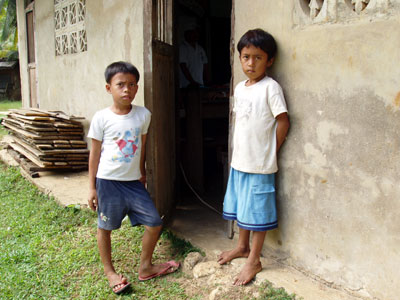
I thought the meeting would last through the morning only, but by lunch we were only halfway done. Which was fine, since nobody seemed to be in a hurry. Except for one little problem. Way too much material was being presented, and much of the information was too complicated or irrelevant. Imagine a room full of people, most of whom never had the chance to complete elementary school.
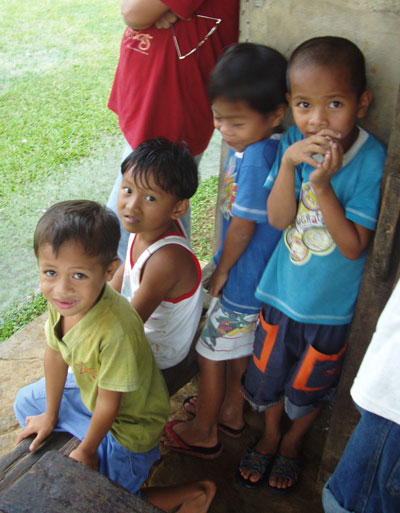
That was the audience, and nearly every attendee brought with them a young child, or three. So while the kids squirmed and screamed, their parents and grandparents were supposed to follow the guy talking about how trash is leading to problems in the ozone layer. They were told that there is more garbage now because people are replacing TVs with newer models more often than before. And they heard how hazardous nuclear waste can really be.
If people in America, who generate the most trash per-capita, donít give a hoot about the ozone, why should a purok of poor Filipinos care either, assuming they even understand what ozone is. And since they arenít the ones who never stop TVs (although theyíd like to be, if they had any money) whatís the point of pointing out they canít do anything about? Giving people nuclear waste nightmares isnít gonna do anybody any good either.
So after the meeting, the presenters asked me what I thought of the sessions. I first complimented them on having their act together enough to hold these meetings, and that I thought a lot of the information was important and useful. But I also told them, as nicely as I could, that I thought it was too long, and often very confusing. Also, if you makke people feel helpless, they probably wonít be inspired to take steps to control the waste problem in their purok.
The presenters agreed with me, as if theyíd been waiting for somebody to give them this kind of feedback. They told me they were only regurgitating what they had heard elsewhere, and would like me to help them develop a simpler, more cohesive session guide. Itís very nice to feel useful from time to time.
We finally got back to town around 5, and I hopped the next jeepney back to Tagbilaran. I had planned to cook a pot of spaghetti for the Thanksgiving potluck, but alas there was no time. I was already late. Most of the Bohol volunteers got together to be thankful together. It was a nice, mellow gathering, though we all wished we could be spending Turkey Day with flesh and blood family.
I see a turkey every now and then, but they are far from commonplace. One of the volunteers ordered a turkey from the dad of one of her friends, who has a secret turkey farm in the farway town of Ubay. Sure enough, Thursday morning her friend delivered the turkey, chopped into pieces, and already boiled. So whoever was planning to stuff the turkey with stuffing and carve it up after roasting it was out of work that day.
The next morning I had the rare opportunity to go swimming, in a pool. You might think that since I live on an island I can swim whenever I want, but all the high tide has been at night the past few months, and where Iím at that means if I wanna swim during the daytime, I have to wade about a mile out before I can do some strokes.
The following night was moonlight kayaking. It was a perfectly beautiful night, and the moon was one night past fullness. The Israelis had shown up, and brought with them an American, a Costa Rican, a Singaporean, and two crazy French guys. I invited Sapphire, son-in-law of Mama and Papa Ramos.
Things started off quite fine. The sea was placid, and we started out as a group. But then the wind started picking up. I tried the best I could to keep an eye on Sapphire, because he is deaf, and couldnít hear the instructions about our direction. But pretty soon, we were all separated. It was a small miracle I myself reached the small, uninhabited, unlit Puntod Island.
I searched the island, but Sapphire hadnít arrived. I was nervous, but not too worried, because we all had life vests, and the guides were experienced with rescue situations. So a few of the guides set out at sea, and sure enough, a few hours later, they came back with Sapphire, who had presumably capsized and been floating in the middle. Filipino outdoorsmen and women are a tough, tight knit group, and I enjoy hanging out with them.
We sang and danced and talked about trash and television and how the two are related, and slept on the sand. At daybreak, we packed up and returned to civilization.
I invited the Israelis (Shai and Liat) to come home with me, since nothing beats a free place to stay, and Nang Juaning is absolutely tops when it comes to guest hospitality. We had a nice ten-course dinner, and then I took them out on the town, to the newly discovered treasure of Inabanga, a videoke machine that is out of this world. It sounds better than all the rest, has a wider selection of songs, and has two mics, which means any song can be a duet. If only every videoke machine was like this one.
In the morning, I gave my guests a grand tour of town including the elementary school and the fishponds. Then it was time to take the to the famous Chocolate Hills. We rode the old rickety public bus in order to get a more ďauthentic experience,Ē and since it was a national holiday, and I was already halfway there, I accompanied them to Nuts Huts, one of the most relaxing places in the world (if you donít mind animals and insects and falling coconuts conducting a 24-hour nature symphony.)
Once again, I think thatís enough for now. I used to give a preview of what Iíd talk about next post, but it never seemed very accurate.
P.S. My friend and fellow Peace Corps 263 Batchmate, Tommy Schultz, has just updated his website. Not only is Tommy a great guitarist, photographer, videoke singer, and storyteller, but a perfectionist when it comes to web design. And he offers free wallpaper downloads! So make your way over to www.tommyschultz.com. (Plus you can find some photos I took, if you peek around a bit. Sorry I haven't updated my own galleries since September.)
December 07, 2004
It Never Ends.
If anyone out there has a computer or just a monitor or CPU or printer sitting around gathering dust and becoming more obsolete by the millisecond, please consider sending it to the Philippines with my brother when he heads this way at the end of the month. I could easily find it a gracious owner here.
Here's a recap of another crazy set of days.
I went to Tagbilaran to meet with the Peace Corps Washington Inspector General representative. (But before our meeting, I went to the foot reflexologist, ate some organic jackfruit, had a short meeting with Feed the Children, and bought a domestic plane ticket for my brother.) Every few years, an inspector comes around to He make sure everything is running smoothly in-country, and that the volunteers ain't up to no monkey business. He came bearing bittersweet gifts (Tootsie Pops and a Time Magazine with the headline "4 More Years." We had a great conversation, and I twisted his arm enough that he stuck around for dinner. Mama Ramos prepared quite a feast, and Papa seemed thrilled to be eating dinner with the anti-monkey-business guy.
Then we went to get a beer at Bohol Tropics (the place Jimmy Carter stayed when he was in town on a Habitat for Humanity mission a few years ago) where I got to quiz the IG about his job and hear a bit about his life story since his time as a 1960's era Peace Corps volunteer in Panama. However, the IG had to call it a night rather early, as he'd been on a 5am to 9pm schedule for the past two weeks. Trying to visit forty volunteers in a country where you might need to take five forms of transport per volunteer is not an easy task. But somebody's gotta do it.
Next day: Casey had spent the night, and we got up mad early to meet Pete in town, and headed for Bohol Divers. The dive was probably the most boring I've been on. I'd rate it an eight. Maybe that's too generous, but I'm thankful Pete's weightbelt didn't clunk me on the head when it fell off. My ears and nose congested, so I stayed on-board while the rest went for the second dive, which they all considered awesome. We waited forever for a bus to take us back to Tagbilaran, all the while being approached by trikes and vans who wished to give us a ride at a special tourist price. (They quickly scurry off when we start speaking Cebuano.) Finally, our divemaster passed by and explained the busses stop running at 3pm. So we had to suck it up, and squeezed in the smoke-belching trike. We got back to Tagbilaran and killed a few hours waiting for Papa to finish selling peanuts. Then we hit "Sky's D Limit" where they sell disgusting meat on sticks and offer a pretty decent videoke machine.
The day after that: We'd been out quite late singing karaoke with Papa, but woke early again, in order to buy some produce at the organic tabo (market) at the provincial capitol building. Pickins were slim, seeing that there were only two farms vending, and organic bounties have never been counted by the truckload.
In the afternoon, Papa and I went on a field trip to Rubin Balistoy's Purple Life Farm, one of the two represented at the tabo. Rubin is the man! He is super knowledgeable about many facets of farming and biodiversity, and he was more than willing to teach us about his organic sasso chicken, his practically-free rice hull carbonization technique (for use as fertilizer.) He is the president of BISAD (Bohol Initiators for Sustainable Agriculture & Development) and indeed the right man for the post. He shared with me a whole slew of contacts that would help keep me busy for the next few days. He picked his last ripe buongon off the tree, and gave me a great deal. When we got home, Papa enthusiastically told Mama how wonderful organic farming is.
I got up bright and early the next day to visit the GTZ office. (GTZ with the "Z" pronounced "zed" is of course the short way to say Deutsche Gesellschaft fŁr Technische Zusammenarbeit.) I had heard they were promoting Constructed Wetlands or Reed Beds, simple technology to suck up things that do not make for a happy, healthy water supply. They are promoting it specifically for communal wastewater concerns, such as fecal matter and laundry detergent. But it has been successfully implemented in factory settings, and I think it might work well for chemical dyes used in the yet-to-be-built loomweaving dyeing center. I left them a blank CD and they promised to burn me some PowerPoints when their computer was feeling better.
Next, I took a shortcut through the award-winning Provincial Library, and turned the corner, into the offices of BEMO, (Bohol Environmental Management Office) where I met with the head of the Solid Waste Division. They are ramping up efforts to promote proper separation and disposal of trash here in Bohol. They really seem to "get" the urgency of the matter, and have some good ideas for implementation of solutions. Still, they say they are a demand based agency, and have only really found success when they help people and municipalities who request assistance (as opposed to just showing up, saying "Hi, we're BEMO and we're gonna make your world a better place.") As my mom always says, "Daniel, god helps those who help themselves."
I am getting sick of hearing the excuse "we Filipinos are hard-headed," so I've decided that instead of getting upset with people who don't want to listen, I should try to work with those who are eager to hear me yap and then ask me plenty of questions. The least hard headed are the children. Especially the young children. Sure, they are used to throwing their junk food wrappers everywhere, and they are used to breathing burning plastic (to keep away dangerous mosquitoes) but they know nothing else, and will probably be least resistant to change if the reasons for change can be explained simply and provide direct benefit to them.
So I asked BEMO what municipalities in Bohol are taking proactive steps to educate the people and the kids about waste. Without having to think about it, the answer was Albur. I got the contact info for the Albur folks, chatted a while longer, and hurried to get some delicious organic veggies and rice from the stall Rubin's sister runs at MacJac, an outdoor cafeteria where food is cheap and served with no wait. While eating, I received a nice text from BEMO saying thanks for the visit and anyone who wishes to help the environment is always welcome in our office.
Before I had time to digest, I was on a jeepney headed for the Office of Provincial Agriculture to meet Salvio, a friend of Rubin. This guy is unlike any Filipino I've met before. He told me a story about running a month-long organic farm camp for rural farmers. He demonstrated the techniques and the farmers were able to see the positive results. However, when the farmers returned to their respective farms, they resumed use of expensive and harmful chemical fertilizers.
Salvio wondered why. He realized that he had simply told the farmers "this is the better way, this is how to do it," instead of letting the farmers arrive to this conclusion on their own From then on, he decided that if he were to see positive results from his trainings, he'd have to involve the participants in the Socratic method or critical thinking. I asked Salvio for an example of critical thinking. He likes to explain it like this: If I get really angry at you, and just punch you in the face, that is not critical thinking. However, if I think for a second that if I hurt you, I might have to pay for your medical bills, and not be able to feed my family. And if I kill you, then maybe I'll end up in jail, and won't be able to feed my family either.
He started telling me about a community gardening program that involves critical thinking, but I had to cut our meeting short, because I was late for an important date. I busted over to Island City Mall. I had promised Sonny I'd treat him to a movie at Screenville for his 45th (or maybe 46th) birthday, which was November 1. Sonny's wife, Bebie, brought him to Tagbilaran. I think it was Sonny's first trip to a mall, and first time to the movies. Sadly for Sonny, there were no real-live action movies playing, so he opted for the animated version, The Incredibles. Not a bad choice.
Then back in town to use the internet at Townsaver Internet Cafť, where they've installed Firefox on all the machines. (And at 10 pesos an hour, it's 50% cheaper and a heck of a lot faster than my rinky-dink dial-up connection at home. But hey, I wasn't expecting any internet access in the Peace Corps.) As I was leaving the place, I noticed the two other foreigners in the place staring at Hebrew websites. I don't usually talk to strangers, but I couldn't help but ask what they were doing in town. Just tourists. OK, fine, I've seen Israelis all over the world, but never in Bohol. Oh, well, we had a crazy friend who really recommended the Philippines. Is there anything to do in Bohol? So I gave them a list of possibilities, invited them to our upcoming Thanksgiving dinner, and told them they might be able to get in some moonlight kayaking. We got kicked out of the cafť because closing time came way too fast, and I introduced them to papa, who was still selling peanuts at 10pm. His co-vendors were all taking the night off, and so he was taking advantage of brisker-than-usual sales.
Early the next morning, Papa and I headed for another organic farming field trip. Reliable sources tell me that Mrs. Darunday spent twenty-five years as an executive at Shell, and decided it was time to give something back. On her farm, Cedar Farms, they raise pigs differently. Instead of using expensive commercial feeds with growth hormones, they feed the pigs rice hulls and vegetables, costing next to nothing. Instead of keeping the pigs in small cement pens, the pigs live and play in large, breezy, corral with a sawdust floor. The pigs don't need cleaning in this environment. And because they can run around, they grow strong, eliminating need for growth hormones. When the fiesta arrives, the poor things still must be slaughtered, but the meat is leaner, and commands a higher price at the market. (I wish people didn't slaughter pigs or goats or cows or dogs or chickens or fish, but I'd have better odds persuading Mr. Prez to sign the Kyoto Protocol than convincing a Filipino to change their viand. Having said that, there are scattered vegetarians sprouting up around the Philippines.)
Mrs. Darunday is experimenting with organic ube (like sweet potato) and other veggies. She's also got a swell compost pit going, and some of the nicest farmhands a farmer could want. BISAD is quite lucky to count her as a member and advocate.
From the farm, I called up the MPDC Municipal Planning and Development Coordinator) of Albur. I told her I'd heard good things about her programs, and that I wanted to meet her. She said "Not today, cuz I have visitors coming from BLDF (Bohol Livelihood Development Fund.)" So I said "Well, actually, that's perfect, I've been wanting to meet those folks, if it's alright with you and them." "Sure, great, hurry on over." So with no time for a sit-down lunch, I picked up some hot corn, a green mango, and some graham crackers from street vendors, and hopped another jeepney, for an hour-long dusty haul...
And for your sake and mine, I'll pick up from here later this week. I don't know how interesting this all is to anyone out there, but it's my life, and I'm sticking to it. After all, what other choice have I got? (I absolutely cannot write fiction.)
December 04, 2004
OK in Bohol.
Sorry for long time, no update. I promise one very soon, like tomorrow or the day after that.
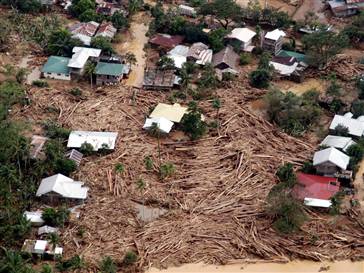
(Source: Philippine Air Force via AP Caption: Carried by floodwaters, thousands of illegally cut logs are lodged between homes in Real, a Philippines town hard hit by this week's landslides.)
The devastating typhoons and flooding here in The Philippines have made international headlines. A few people have emailed to see if I'm alright. Thankfully yes. If you look at a map, you can see the island of Bohol is pretty well shielded by other islands. However, there are fellow Peace Corps Volunteers and many people I know who have relatives in the hardest hit places. Let's pray for them, and for an end to environmental destruction.
Here's the word from the world-famous home of gloom and doom with a sense of humor, a bacon in the smog, Grist Magazine:
PHILIPPINE PHILIPPIC
Illegal logging in Philippines contributes to flood devastation
Recent storms in the Philippines have wreaked havoc on the country, with hundreds killed or missing in landslides and floods, and enviros and government officials are both taking aim at what they call a principal culprit: illegal logging. Though unusually high rainfall and the geography of the region contributed to flooding, it didn't help that forest cover on the islands has gone from 64 percent in 1920 to less than 18 percent today, making the hilly land vastly more prone to erosion, mudslides, and flash flooding. "Illegal logging must now be placed in the order of most serious crimes against our people," said President Gloria Arroyo in a statement. Problem is, the country's people are driven to logging by persistent poverty, and with the population (84 million) expected to double in the next 50 years, some enviros predict that primary forest cover could be effectively eliminated within 20 years if logging continues at current rates.
straight to the source: MSNBC.com, Reuters, 03 Dec 2004
straight to the source: Terra Daily, Agence France-Presse, 01 Dec 2004